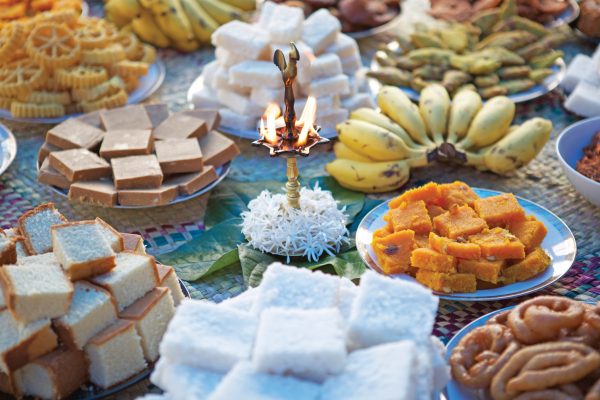
As the Sinhala and Tamil New Year approaches, it brings with it a sense of joy, togetherness, and the anticipation of indulging in an array of mouthwatering sweets. This auspicious occasion, celebrated by both Sinhalese and Tamil communities in Sri Lanka, marks the beginning of the traditional New Year and is a time for families to come together, exchange gifts, and enjoy delicious homemade treats.
Amidst the vibrant festivities and cultural traditions, one of the highlights of Sinhala and Tamil New Year celebrations is undoubtedly the assortment of sweets that adorn every household. These delectable treats not only tantalize the taste buds but also hold significant cultural and symbolic meaning, reflecting the richness of Sri Lankan culinary heritage.
Let us delve into the world of Sinhala and Tamil New Year sweets, exploring their origins, flavors, and the joy they bring to the festivities.
- Kokis – Crispy Delights of Tradition:
- Kokis, with its intricate shape and irresistible crispiness, holds a special place in the hearts of Sri Lankans during the New Year celebrations. Made from a batter of rice flour, coconut milk, and spices, kokis is deep-fried to perfection, resulting in a delicate golden hue and a satisfying crunch with every bite. The intricate patterns imprinted on kokis signify prosperity and good fortune, making it a must-have delicacy during the New Year festivities.
- Mung Kavum – Sweet Morsels of Goodness:
- Mung Kavum, also known as green gram fritters, is another beloved sweet enjoyed during Sinhala and Tamil New Year celebrations. These bite-sized delights are made from a mixture of green gram flour, rice flour, coconut milk, and jaggery, which is then deep-fried until golden brown. The sweet aroma of mung kavum wafting through the air is enough to entice anyone to indulge in these delectable treats, symbolizing prosperity and abundance in the coming year.
- Aasmi – Heavenly Threads of Sweetness:
- Aasmi, with its delicate and intricate appearance, is a labor of love that graces the tables of many households during the New Year festivities. Made from a mixture of rice flour, coconut milk, and sugar syrup, the batter is carefully drizzled onto a hot griddle in intricate patterns, creating thin, lacy threads of sweetness. Aasmi not only delights the senses with its heavenly taste but also symbolizes the intricate and interconnected nature of family bonds during this auspicious time of the year.
- Aluwa – The Sweet Symbol of Unity:
- Aluwa, a traditional Sri Lankan sweet, is a rich and indulgent treat made from rice flour, jaggery, coconut, and an array of aromatic spices. This dense and fudgy sweet is often flavored with cardamom, nutmeg, and cloves, giving it a distinctively warm and comforting taste. Aluwa is traditionally shaped into squares or diamonds, symbolizing unity and harmony within the family, making it a cherished delicacy during Sinhala and Tamil New Year celebrations.
As we prepare to usher in the Sinhala and Tamil New Year, let us embrace the spirit of togetherness and celebration by indulging in these traditional sweets that have been passed down through generations. May the sweetness of these treats fill our hearts with joy, prosperity, and the warmth of cherished traditions as we welcome the New Year with open arms. Wishing everyone a happy and prosperous Sinhala and Tamil New Year filled with love, laughter, and an abundance of sweet delights!